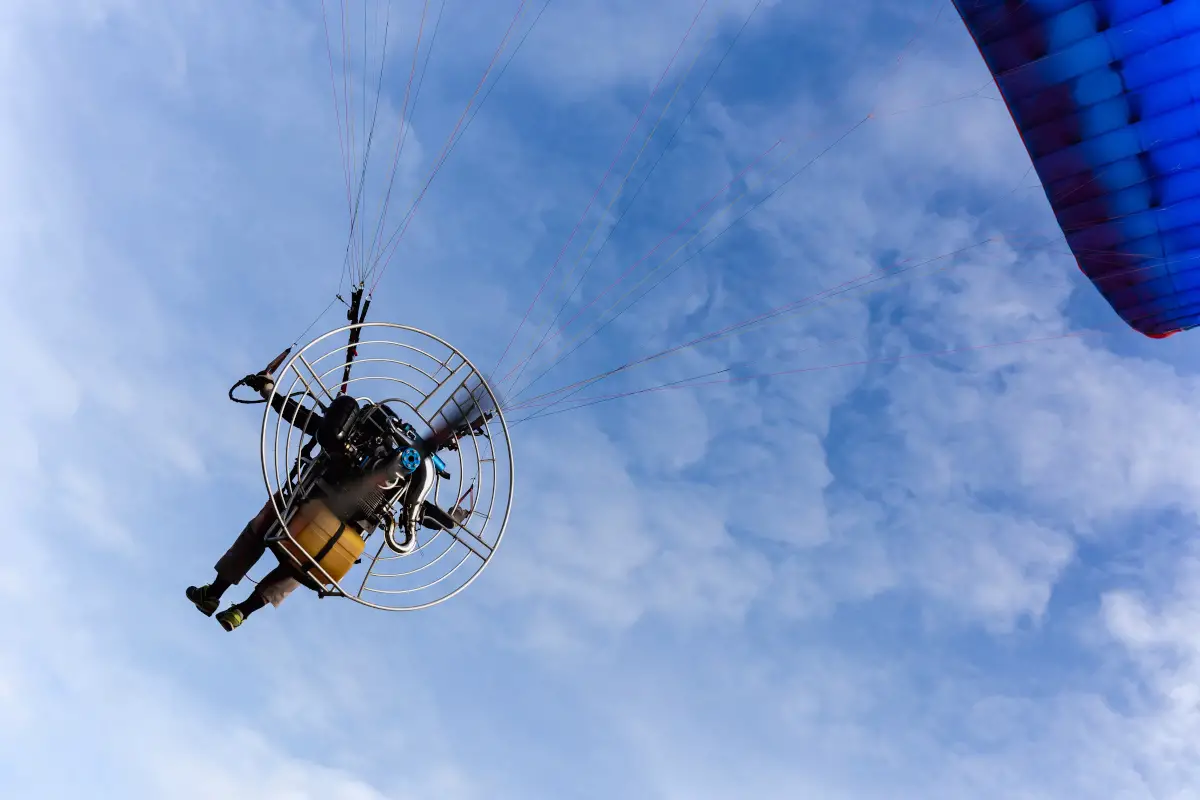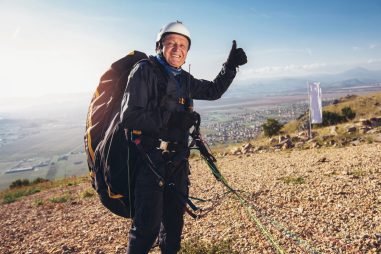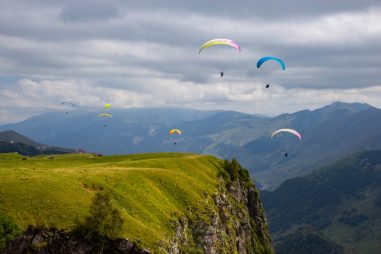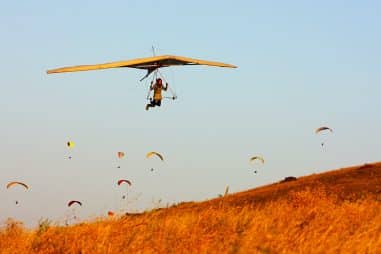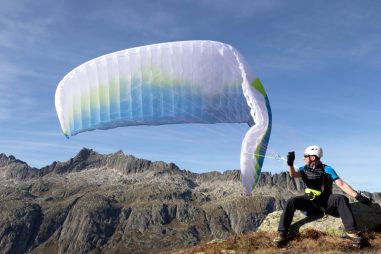Powered paragliding is generally safer than traditional paragliding. However, you are required to have a P2 certification to fly on your own. It can range for up to 200 mi (321 km) based on weather conditions and flying style. It is also considerably more expensive because of the additional equipment.
Do Paragliders Have a Motor
Yes. Paragliding with a motor is called Powered Paragliding or Paramotoring. The motor is a giant fan worn on your back that will help you move forward and upward. A paramotor will allow you to launch from the ground, on a hill, mountain, or any open field, unlike a traditional paraglider. It also doesn’t rely on wind, so you have more flexibility to fly.
Like traditional paragliding, powered paragliding requires no pilot license and minimum supervision. Though, you will also need to train in a paragliding school certified by the USSPA or EHPU and receive a certification of P2, meaning you have the skills, knowledge, and exemplified good judgment to fly without direct supervision.
What Do You Call a Paraglider With an Engine
A paraglider with an engine is called a paramotor. It is considerably heavier than a traditional paraglider, but it can launch in any open field from the ground.
A paramotor works best at speeds from 12mph to 18mph (19kph to 29kph) and can still manage wind speeds up to 45mph (72kph). You don’t solely rely on thermals when paramotoring but most pilots do because it helps save fuel.
You have more control over where you want to be in paramotoring, and it is easier to learn than traditional paragliding because you don’t rely on wind as much. Although this is the case, both require training to be well versed in varying wind conditions and to make better decisions while on air.
How Does a Powered Paraglider Work?
The motor or engine placed on your back will help propel you forward. It will be your source of thrust throughout the flight. It comprises three parts: the motor frame, engine, and propellers.
- Motor frame: Is durable and made with lightweight materials, like aluminum or stainless steel tubing or titanium or carbon fiber.
- Engine: There are two different types, but the most common is single-cylinder two-stroke motors. They have high running-speed capabilities and weigh lesser.
- Propellers: Made of carbon fiber or wood. It is susceptible to damage, so proper training is required to avoid this.
The engine and propellers are attached to the motor frame. A throttle cable runs through the frame to your hands from the engine. It will allow you to turn the motor on and off. Some engines have an electric start, while others have a pull starter.
Is Motorized Paragliding Safe?
Yes, motorized paragliding is safe. In fact, it is much safer than traditional paragliding. Most accidents in motorized paragliding are usually a pilot’s failure to make a wise judgment while airborne. Here are some things you can do to keep you safe while paramotoring:
- Check the motor before flying, see if there is damage to the propellers, check if the engine has enough fuel, and if they are all secured to the motor frame.
- Prepare a flight plan before flying, including where you will launch and land.
- Check the weather conditions before flying. Postpone your plans if there is a weather forecast of rain, storm, or high-speed winds.
- Choose a paramotor that best fits your skills and your weight.
- Inspect the glider and the lines and risers.
- Complete safety training in a USPPA (the United States Powered Paragliding Association)– or EHPU (European Hang gliding and Paramotoring Union)–certified paragliding school.
- Ensure you have a reserve parachute in case of an emergency.
- Avoid flying above water over 12 feet (4 meters) deep.
- Check NOTAM (Notice to Air Missions) before leaving to know if there are aircraft hazards.
- Avoid flying low enough that you may hit electric lines or trees.
- Schedule regular maintenance for all your equipment.
As a responsible pilot, you also want to account for the safety of other pilots in the air. Then, the best thing you can do is to be trained and receive at least a P2 certification, as it signifies that you are knowledgeable and have the skills to fly and make decisions well.
How Dangerous Is Powered Paragliding?
Powered paragliding is not dangerous. It is relatively safer than traditional paragliding and driving a car. A few causes of a powered paragliding accidents are when propellers hit the pilot on the back, when engines die in the air, or wrong judgment from the pilot. As a responsible pilot, you want to guarantee that you have a working reserve parachute with you before flying in case of an emergency.
At all costs, you want to avoid the risk of injury from body contact with the propeller. It usually happens when the engine is difficult to start, but it is preventable. Maneuvering in a spiral or wingovers is also dangerous but can be averted with training.
Is Powered Paragliding Legal?
Yes, powered paragliding is legal. Although it is not closely supervised, USPPA or EHPU expects you to follow regulations under powered paragliding and govern yourself. Some of these regulations include the following:
- You have received a certification of at least P2 or higher.
- Use of powered paraglider solely for recreation and sports.
- Use for only one occupant. If you plan to do tandem paramotoring, you may need additional certification.
- Flying within Classes G and E airspace.
- Use of correct engine within your weight and skills.
- Follows the keep right, steer right rule, and the right of way rule.
- Flies 500 feet (152 meters) above ground.
- No paramotoring at night.
Following these regulations is part of your responsibility as a pilot and ensures the safety of those around you.
Do You Need a License to Fly a Powered Paraglider?
No, you don’t need a license to fly a powered paraglider. However, it is mandatory to receive training from a paragliding or paramotoring school. They must be USHPA- or EHPU-certified to be credited. You will also need to acquire a P2 certification, conveying that you have the knowledge and skills and have exemplified good decision-making without assistance.
You can usually learn to fly within one to two weeks. You can then apply for P2 certification through a certified paragliding or paramotoring school. A member of the USPPA or EHPU will then give you a written and actual test.
Where Can Powered Paragliders Fly?
You can fly a powered paraglider generally in uncontrolled airspace, classes G and E. Anything above this class is for commercial, private, or government use only. Locations unrestricted to powered paragliding or where you have received permission are the best places to fly. Here are some more to consider:
- A location where there are no electric lines.
- Launch and land in a location clear of any debris. For instance, huge boulders or trees.
- Anywhere in the area away from 12-foot- or 4-meter-deep water.
- Neighborhood with permission from city regulator.
Research if there are current restrictions in the area before launching, flying, or landing there. Get the permits required to avoid fines. Follow the regulations on each location for the benefit of all pilots.
Can You Power Paraglide Anywhere?
The answer is no. You can’t go power paragliding anywhere. But, like traditional paragliding, there are certain restrictions when flying a lightweight aircraft. Here are some of those:
- Airspace above Class G: The airspace above this class is prohibited from light aircraft and is only for commercial or government use.
- Airport: Airports without an FAA grant will not allow powered paragliding in their area. An airport with an FAA grant must follow Airport Improvement Plan Assurances to ensure that powered paragliding is regulated and will not harm other aircraft.
- Highly congested areas: Cities with tall buildings or dense population is not allowed for powered paragliding.
- Organized events: Powered paragliding is not allowed within 1000 meters (0.62 miles). You also cannot fly over to the event.
- Private land: You will need special permission from the private land owner to launch and land in the area.
- Government land: Includes national parks or any land owned by the government and is solely for government use.
Be more especially mindful when flying over neighborhoods. Avoid receiving complaints as much as possible. Continuous complaints often result in a permanent ban on pilots.
What Is the Range of a Powered Paraglider?
A powered paraglider has an average range of two to three hours, depending on wind conditions, fuel, overall weight, and flying style. The type of engine is also a contributing factor. For instance, a stronger and heavier engine eats more power, while a lighter engine is faster but carries little fuel.
Your wing choice is another factor that will also affect the range of your paraglider. Some gliders create more drag than others, so you’ll want to explore and work with professionals to choose the most ideal wing for your motor.
How Far Can You Go on a Powered Paraglider?
A powered paraglider can go up to 217 miles (349 kilometers). This is the range of a single fuel tank in perfect weather conditions. Hence, the span is again dependent on a variety of factors: wind speed, overall weather condition, your overall weight, and flying style.
Cross-country and adventure flying became even more popular because of powered paragliding. Some designs have a specialized motor that will allow you to bring a regular fuel tank or two tanks.
How High Can a Powered Paraglider Fly?
A powered paraglider can fly up to 18,000ft (5,400 m). The minimum is 500ft (150m) above ground. It is similar to a traditional paraglider, but the elevation is much faster in a motor.
The motor is also perfect for thrust and altitude, but professional pilots utilize thermals to lessen fuel usage and fly farther. The key is to learn how to maximize your fuel by being adept at paragliding.
How Fast Do Powered Paragliders Go?
A powered paraglider can go from 20mph to 30mph (32kph to 48kph). Professional pilots can go up to 45mph (72 kph), but again, it is dependent on weather conditions and skills.
The motor will help you fly faster, but note that flying faster means it eats more fuel. A good pace is where you can balance fuel use and wind speed. Powered paragliders cannot go any further than 55 knots or 63mph unless approved beforehand.
The paramotor’s wing can also affect your overall speed. For instance, the fastest wings have a higher aspect ratio and focus on speed and maneuverability. These wing types are for advanced pilots with much experience flying safely and proficiently.
How Do You Take Off With a Powered Paraglider?
There are two ways to take off with a powered paraglider based on your motor. The first way is called a foot launch and is considered the most popular way of powered paragliding. If doing a foot launch isn’t possible, another option is by a trike.
- Foot launch: You wear the paramotor on your back, turn on the cable throttle that connects to the engine, and briefly run until the wing lifts you and the motor off the ground.
- Trikes: The trike is attached to the paramotor and glider before launch. You sit on the trike, turn on the engine and allow the motor to provide thrust until the wing lifts you off the ground.
As always, check the surrounding area and perform an inspection on your equipment before attempting to take off. Make a flight plan, and know which locations are best for landing.
What Engine Does a Paraglider Use?
There are two engines a paraglider uses. One is a 2-stroke engine, while the other is a 4-stroke engine. The first is the most popular amongst pilots for its thrust ability, while the latter is known for being more fuel efficient. Choosing between these two will depend on what you want to achieve in powered paragliding.
The common problem with a 2-stroke engine is it uses up fuel quickly because of the power. On the other hand, a 4-stroke engine is perfect for saving fuel but doesn’t generate as much power. Unfortunately, you can’t have both!
How Much Does a Powered Paraglider Weigh?
An average powered paraglider weighs between 40lbs (18kg) and 75lbs (34kg). The overall average weight limit of a powered paraglider, you included, is 352 lbs (160 kg). It can be heavier but may need specific certification as it is usually for tandem flying.
Safety regulations require that there is a weight limit for powered paragliding. Anything above the weight limit is considered dangerous to the pilot, such as a risk of engine failure.
How Much Does a Motor Paraglider Cost?
A motor paraglider can cost up to 8,000USD based on the quality of equipment. If you include the glider, the cost is between 9,500USD and 15,000USD. Of course, this doesn’t cover the cost of training and other tools and equipment you’ll need to fly safely.
You want to avoid buying secondhand equipment as you don’t know its overall quality. But if ever you do, consider bringing an expert with you to help ask questions. Used equipment is usually half the price, making it considerably cheaper.
How Much Does It Cost to Get Into Powered Paragliding?
The cost is expensive. Nevertheless, this doesn’t make powered paragliding any less worth it because once you have everything you need, you don’t pay for anything else other than regular maintenance. So it’s definitely worth all the money, time, and effort.
- Paramotoring school: Costs 1,500USD to 3,000USD.
- Motor: Costs 6,500USD to 8,000USD.
- Paramotor wing: Costs 3,000USD to 6,000USD.
- Helmet: Costs 300USD to 500USD.
- Flight suit: Average cost of 1,200USD.
- Altimeter with variometer: Costs 500USD to 700USD.
- GPS: Costs 200USD to 500USD
- Reserved parachute: USD 500 to USD 900.
All this training and equipment will last you a long time, approximately 300 hours, based on how well you take care of them. Regular maintenance is every 100 hours.
What Is the Best Powered Paraglider?
There are a lot of good powered paragliders in the market, but the best one will depend on your needs as a pilot. There are several factors to include before deciding which is the best paraglider for you. These are weight, fuel efficiency, thrust power, durability, ease of control, and cost. Here are five powered paragliders that meet most of these criteria.
- Parajet Maverick: Has 17-liter tank fuel but is not best for beginners.
- Miniplane ABM Flex Gage: Can handle weight over 200lbs (90kg) but is not ideal for long trips.
- Blackhawk Black Devil 172: Can handle weight over 285lbs (129kg) and is perfect for tandem flying.
- Scout One Carbon: On the pricey side but perfect for a lightweight and durable design.
- Air Conception Titanium Nitro 200: Lightweight with a 28-horsepower engine.
The choice of paramotor will solely depend on your level of skill and experience as a pilot. Other than taking these factors into consideration, include a professional to help you pick the most suitable paramotor for you.
Is Powered Paragliding Fun?
Yes, powered paragliding is fun! It takes a lot of time and work, but it is worth all the effort. It provides a different sense of freedom once you are flying on your own. It is also a humbling experience, one that gives you more respect for nature.
If you want to know if powered paragliding is for you, you can begin by going on a tandem flight with a professional. Then, you will learn by experience how it actually is to stay airborne and how quiet and peaceful it really is.

